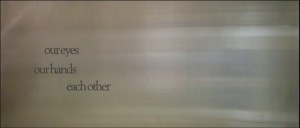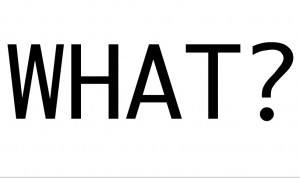Â
[In this post: Letters demand things; Young-Chae Heavy Industries]
When a text becomes a work of art, when we look at an ordered string of letters not for the meaning it carries but just as curve and straight lines combined together, are we still entitled to talk about literature? Or is it already something that trascends literature itself?
This is the question that I am asking myself since I saw Michael Madsen’s “Letters demand things“. I believe that it is a perfect example of how art and literature easily intertwine in the realm of the digital media. This project makes you play with the sound and the shape of the letters as if the reader is the one who can free them from the obligation of composing words that carry meaning. Letters want to live just as signs, they need to be looked at for what they are without the burden of something to communicate, they are longing for a sort of reification: “they now demand to be typed, spoken, traced, heard, and related to in specific ways. And yet, for all their demands, they only exist as reflections of human handwriting and visual echoes of muscles and air working in concert to give them life as sound waves”, Madsen declares in his initial statement.
Art that deals with letters, words that lost their meaning.
This reminds me about Concrete Poetry and its attention for the graphic aspect of poems. But it was still labelled as Poetry. Boundaries are blurring.
Another interesting work which poses itself in between for being an artistic approach to words and poems, as its very creators say, is Young-Hae Chang Heavy Industries. This artist duo set in South Korea but influenced by manifold cultures and traditions has exhibited its masterpieces in many famous museums and galleries, such as the Centre George Pompidou in Paris, the Tate Modern in London and the New Museum here in New York. They use a simple graphics, mainly just black letters against a white background, combine it with marvelous jazz music, and as a result you get a poem that line by line, and sometimes word by word, jumps, bounces and floats on your screen. No links and no hypertexts. Even though I feel less iffy about seeing it as literature than Madsens’s work, it is not “electronic literature” in its common sense. There are no links, no hypertexts, no different paths to choose among. The only choice the reader has – and they are absolutely aware of that – is pushing the “Back” button. According to them, it doesn’t mean that the reader is a passive receiver because she has in her hands the strongest power of choice, that is to say Stop.
I believe that this power is the same as the one of closing a book when we do not want to read it anymore. Or better, it is more than just a power, it is an Inalienable Right of the Reader.
But is it what we really want from electronic literature? One can argue that what they are doing is miles away from what we mean with that. Personally speaking, I really like Heavy Industries’ works but I feel that there it lacks the “playable”and interactive part of electronic literature.
But there is a subtle mistake in all this reasoning: we should avoid a perspective which is too literary-bounded and take into account that one of the added values that media art has is combining different fields and perspectives, such as literature and art, so to create a unique intermingling matter. Sometimes we like it, sometimes we don’t, but its value lies in its capacity of astonishing and surprising us.
One thing that this research about electronic literature seems to desperately want to teach me is that I have to be ready to have my expectations unmatched and marvel at mundane things as it was the first time. Even if it seems hard to get rid of traditional concepts and prejudices, they sometimes are just a ballast to dump so…let the hot-air balloon of our imagination and creation fly.



